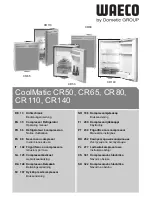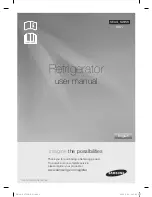
10
2.
Heat dissipation space
When working, the refrigerator gives off heat to
surroundings. Therefore, at least 300
mm of free
space should be spared at the top side, more
than 100 mm on both sides, and above 50 mm at
the back side of the refrigerator.
3.
Level ground
Place the refrigerator on the solid and flat ground
(floor) to keep it stable, or else, it will give rise to
vibration and noise. When the refrigerator is
placed on such flooring materials as carpet, straw
mat, polyvinyl chloride, the solid backing plates
should be applied underneath the refrigerator, so
as to prevent color change due to heat
dissipation.
Unobstructed ventilation shall be
maintained around the appliance or in an
embedded structure.
Preparations for use
1.
Standing time
After the refrigerator is properly installed and well
cleaned, do not switch it on immediately. Make
sure to energize the refrigerator after more than
1 hour of standing, so as to ensure its normal
operation.
2.
Cleaning
Confirm the accessory parts inside the
refrigerator and wipe the inside with a soft cloth.
3.
Power-on
Insert the plug into the solid socket to start the
compressor. After 1 hour, open the freezer door,
if
the
temperature
inside
the
freezer
compartment drops obviously, it indicates the
refrigeration system is working normally.
4.
Storage of food
After the refrigerator runs for a period of time, the
internal temperature of the refrigerator will be
automatically controlled according to the user’s
temperature setting. After the refrigerator is fully
cooled, put in foods, which usually need 2~3 hours
to be fully cooled. In summer, when the
temperature is high, it takes more than 4 hours for
the foods to be fully cooled (Try to open the
refrigerator door as less as possible before the
internal temperature cools down).
If the refrigerator is installed in the moisture
place, make sure to check whether the ground
wire and leakage circuit breaker are normal. If
vibration noises are produced due to the
refrigerator contacting the wall or if the wall gets
blackened by air convection around the
compressor, move the refrigerator away from the
wall. Setting up the refrigerator may cause
jamming noise or image chaos to the mobile
phone, fixed-line telephone, radio receiver,
television set surrounding it, so try to keep the
refrigerator as far away as possible in such case.
Functions
Temperature setting:
The temperature of the refrigerator is controlled
by the control panel mounted in the fridge
compartment.
1.
Under the normal operating condition (in
spring and autumn), it is recommended to
set at Mode 5-8.
2.
In summer when the ambient temperature is
high, it is recommended to set at Mode 2-4,
so as to guarantee the fridge and freezer
temperatures by extending the refrigerator
running time; and in winter when the
ambient temperature is low, it is
recommended to set at Mode 2-4 to avoid
frequent start/stop of the refrigerator.
3.
Fast Cool: When this function is enabled, the
fridge temperature and the freezer
temperature can be reduced rapidly at the
same time, so that foods can be kept in fresh
condition with their nutrition not lost. The
maximum running time of the fast-cool
function is 26 hours, after which, the
refrigerator will be restored to its previous
mode that is set before the fast-cool
function is enabled.
Note: If the indicator light
‘
2
’
or
‘
5
’
or ‘8’
gets flickering, it indicates that the
refrigerator has broken down. Please
contact the after-sales personnel for on-site
service as soon as possible.
Instructions for food storage
Precautions for use
⚫
The appliance might not operate consistently
(there is possibility of defrosting or
temperature becoming too warm in the
frozen food compartment) when sited for an
extended period of time below the cold limit
of the temperature range for which the
refrigerating appliance is designed
⚫
The information of climate type of the
appliance is provided on the rating plate.
⚫
The internal temperature could be affected
by such factors as the location of refrigerating
appliance,
ambient
temperature,
and
frequency of door open, etc., and if
appropriate, a warning that setting of any
temperature control device might have to be
varied to allow for these factors should be













































